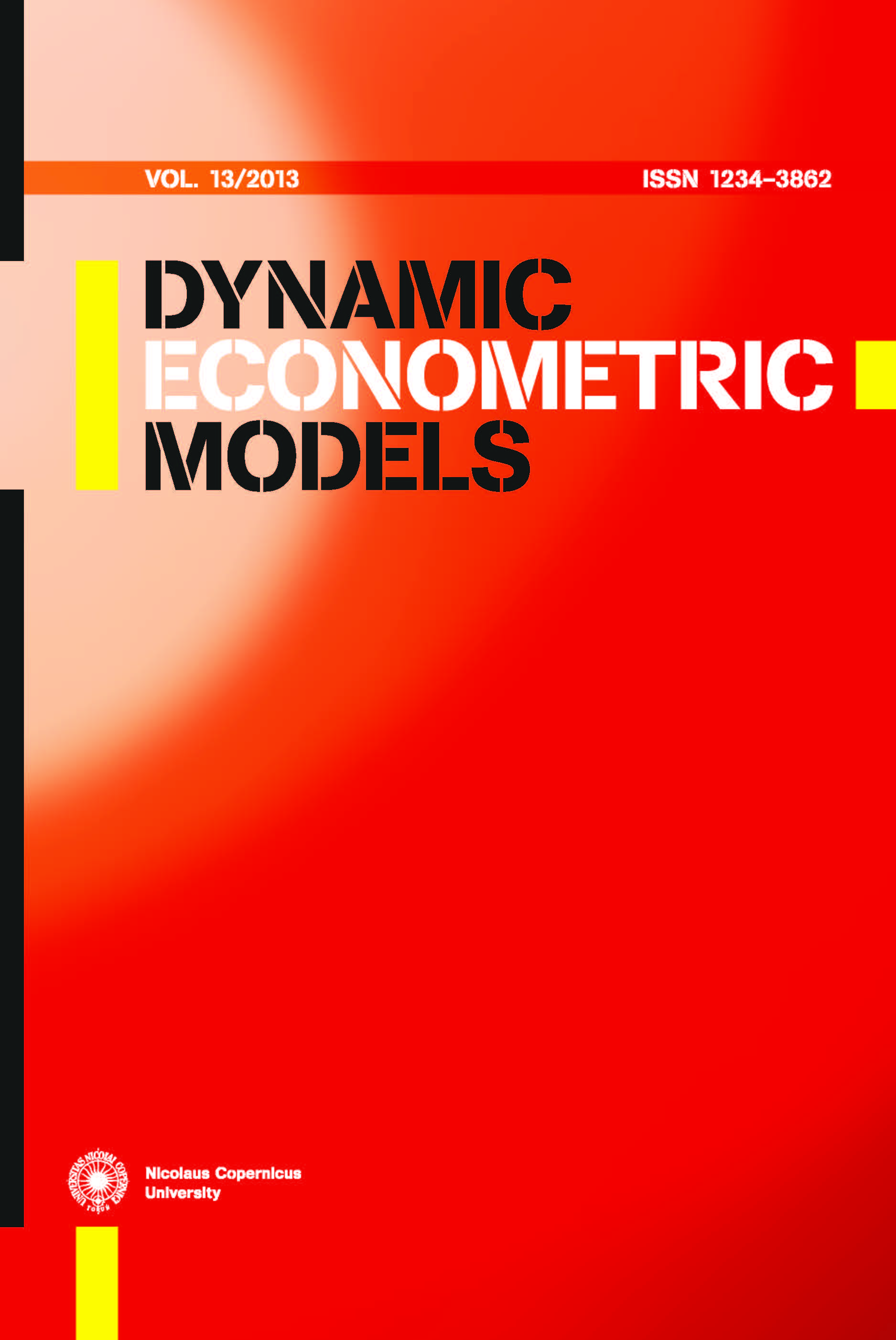Synchronization of Crude Oil Prices Cycle and Business Cycle for the Central Eastern European Economies
DOI:
https://doi.org/10.12775/DEM.2013.010Keywords
Markov switching model, crude oil prices, business cycle, price cycleAbstract
The main purpose of the paper is to study the degree to which the Brent crude oil price cycle is correlated and synchronized with business cycle in a set of chosen Central Eastern European (CEE) economies. To indentify the oil price cycle and business cycles for chosen individual countries the Markov-switching autoregressive model (MS-AR) is used. The identification of the smoothed probabilities of being in regime 1 and regime 2 enables the calculation of correlation coefficients between those probabilities and the concordance index to evaluate the synchronization of oil price cycle and business cycles for the CEE economies.
References
Abel, B. A., Bernanke, B. S. (2001), Macroeconomics, Addison Wesley Longman Inc.
Ang, A., Bekaert, G. (2002), Regime Switches in Interest Rates, Journal of Business & Eco-nomic Statistics, 20(2), 163–182.
Arouri, M., Nguyen, D. (2010), Oil Prices, Stock Markets and Portfolio Investment: Evidence From Sector Analysis in Europe Over the Last Decade, Energy Policy, 38(8), 4528–4539.
Artis, M., Krolzig, H. M., Toro, J. (2004), The European Business Cycle, Oxford Economic Papers, 56, 1–44, DOI: http://dx.doi.org/10.1093/oep/56.1.1.
Backus, D., Crucini, M. (2000), Oil Prices and the Terms of Trade, Journal of International Economics, 50, 185–213, DOI: http://dx.doi.org/10.1016/S0022-1996(98)00064-6.
Bjornland, H. (2008), Oil Price Shocks and Stock Market Booms in an Oil Exporting Country, Norges Bank Working Paper, 16, 1–33. DOI: http://dx.doi.org/10.1111/j.1467-9485.2009.00482.x.
Brown, S., Yucel, M. (1999), Oil Prices and U.S. Aggregate Economic Activity: A Question of Neutrality, Economic and Financial Review, 2, 16–23.
Brown, S., Yucel, M. (2002), Energy Prices and Aggregate Economic Activity: An Interpreta-tive Survey, Quarterly Review of Economics and Finance, 42, 193–208, DOI: http://dx.doi.org/10.1016/S1062-9769(02)00138-2.
Bruno, M., Sachs, J. (1982), Input Price Shocks and the Slowdown in Economic Growth: The Case of U.K. Manufacturing, The Review of Economic Studies, 49(5), 679−705, DOI: http://dx.doi.org/10.2307/2297185.
Chan, K. F., Treepongkaruna, S., Brooks, R., Gray, S. (2011), Asset Market Linkages: Evi-dence from Financial Commodity and Real Estate Assets, Journal of Banking and Fi-nance, 35(6), 1415–1426, DOI: http://dx.doi.org/10.1016/j.econmod.2011.10.006.
Davis, J. S., Haltiwanger, J. (2001), Sectoral Job Creation and Destruction Responses to Oil Price Changes, Journal of Monetary Economics, 48, 465–512, DOI: http://dx.doi.org/10.1016/S0304-3932(01)00086-1.
Dixit, A. K., Pindyck, R. S. (1994), Investment Under Uncertainty, Princeton University Press, New Jersey.
Fisher, I. (1930), The Theory of Interest, Macmillan, New York.
Galbraith, J. K., Hale, T. (2004), Income Distribution and the Information Technology Bubble. University of Texas Inequality Project, http://utip.gov.utexas.edu/papers/utip_27.pdf, (16.08.2013).
Guidolin, M. (2011), Markov Switching Model in Empirical Finance, Innocenzo Gasparini Institute for Economic Research, Bocconi University, Working Paper, no. 415, 1–60.
Hamilton, J. (1988), Are the Macroeconomic Effects of Oil-price Changes Symmetric? A Comment, Carnegie-Rochester Conference Series on Public Policy, 28, 369–378, DOI: http://dx.doi.org/10.1016/0167-2231(88)90031-0.
Hamilton, J. (1989), A New Approach to the Economic Analysis of Nonstationary Time Series and the Business Cycle, Econometrica, 57(2), 357–384, DOI: http://dx.doi.org/10.2307/1912559.
Hamilton, J. (1996), This is What Happened to the Oil Price Macroeconomy Relationship, Journal of Monetary Economics, 38, 215–220, DOI: http://dx.doi.org/10.1016/S0304-3932(96)01282-2.
Harding, D., Pagan, A. (2006), Synchronization of cycles, Journal of Econometrics, 132(1), 59–79.
Hooker, M. (1999), Are Oil Shock Inflationary? Asymetric and Nonlinear Specifications Versus Changes in Regime, Journal of Money, Credit and Banking, 34(2), 540–561, DOI: http://dx.doi.org/10.1353/mcb.2002.0041.
International Energy Agency (IEA), http://omrpublic.iea.org/currentissues/full.pdf, (16.08.2013).
Jimenez-Rodrigues, R., Sanchez, M. (2005), Oil Price Shocks and Business Cycles in Major OECD Economies, Applied Economics, 37(2), 201–228.
Kim, I. M., Loungani, P. (1992), The Role of Energy in Real Business Cycle Models, Journal of Monetary Economics, 29, 173–189, DOI: http://dx.doi.org/10.1016/0304-3932(92)90011-P.
Konopczak, K. (2009), Analiza zbieżności cykli koniunkturalnych gospodarki polskiej ze strefą euro na tle krajów Europy Środkowo-Wschodniej oraz państw członkowskich strefy euro (Business Cycle Synchronization in Poland, the Euro Area and Eastern European Countries), [in:] NBP. Raport na temat pełnego uczestnictwa Rzeczypospolitej Polskiej w trzecim etapie Unii Gospodarczej i Walutowej: Projekty badawcze część trzecia (NBP. Report on the Full Participation of Poland in the Third Stage of Economic and Monetary Union), Warszawa.
Kośko, M. (2006), Application of Markov-Switching Model to Stock Returns Analysis, Dy-namic Econometric Models, 7, 259–268.
Krolzig, H-M., Toro, J. (2005), Classical and Modern Business Cycle Measurement: The European Case, Spanish Economic Review, 7, 1–21, DOI: http://dx.doi.org/10.1007/s10108-004-0088-0.
LeBlanck, M., Chinn, M. (2004), Do High Oil Prices Presage Inflation? The Evidence From G–5 Countries, SCCIE Working Paper, 4, 1–27, DOI: http://dx.doi.org/10.2139/ssrn.509262.
Lee, K., Ni, S. (2002), On the Dynamic Effects of Oil Price Shock: A Study Using Industry Level Data, Journal of Monetary Economics, 49, 823–852, DOI: http://dx.doi.org/10.1016/S0304-3932(02)00114-9.
Loungani, P. (1986), Oil Price Shocks and Dispersion Hypothesis, Review of Economics and Statistics, 58, 536−549, DOI: http://dx.doi.org/10.2307/1926035.
NBER, http://www.nber.org/cycles/cyclesmain.html (16.08.2013 r.).
Pierce, J. L., Enzler, J.J. (1974), The Effects of External Inflationary Shocks, Brooking Paper on Economic Activity, 1, 13–61.
POPiHN (2013), Przemysł i handel naftowy. Roczny raport 2012, Warszawa.
Stawicki, J. (2004), Wykorzystanie łancuchów Markowa w analizie rynku kapitałowego (Ap-plication of Markov Chains in Stock Market Analysis), Wydawnictwo Uniwersytetu Mikołaja Kopernika, Toruń.
Downloads
Published
How to Cite
Issue
Section
License
The journal provides an Open Access to its content based on the non-exclusive licence Creative Commons (CC BY-ND 4.0).
To enable the publisher to disseminate the author's work to the fullest extent, the author must agrees to the terms and conditions of the License Agreement with Nicolaus Copernicus University.
Stats
Number of views and downloads: 464
Number of citations: 0



